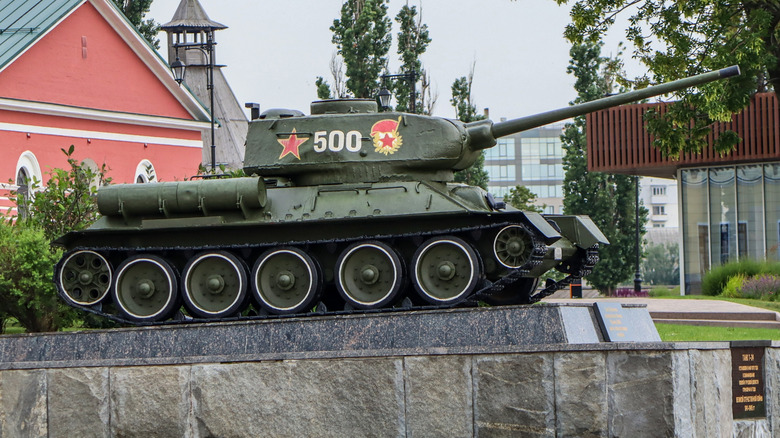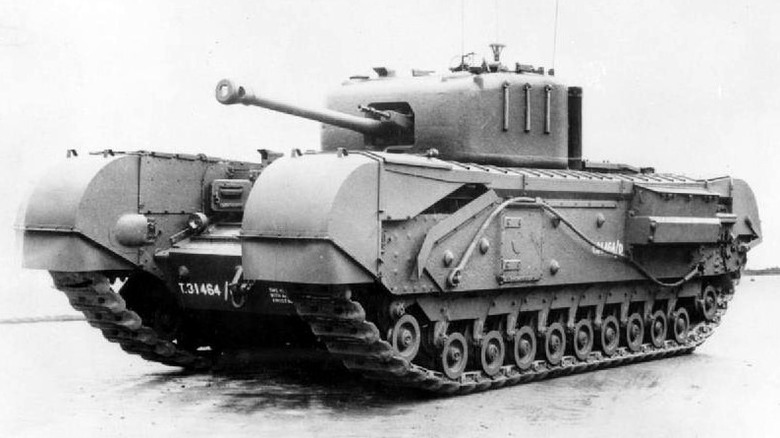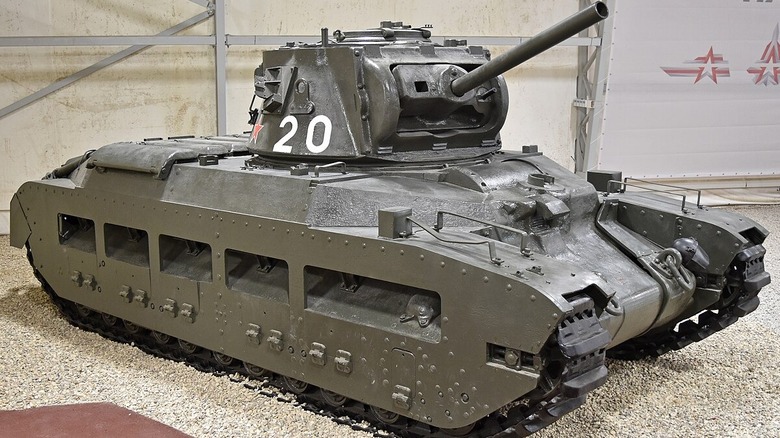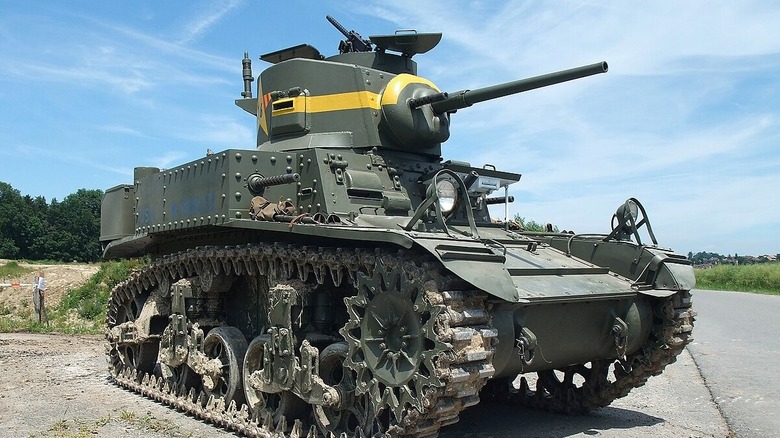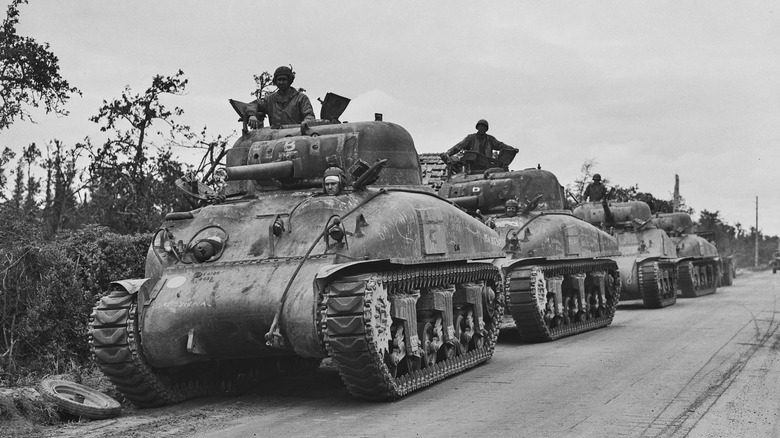The 5 Most Important Allied Tanks In WW2 History
The First World War introduced the horrors of trench warfare. Thousands of artillery pieces launched millions of shells over frontlines brimming with infantrymen struggling in the mud for mere feet of ground. Tremendous battles produced millions of casualties while shifting front lines by mere meters.
Both sides sought technology that might tip the war in their favor. Overhead, increasingly sophisticated fighter aircraft tangled in fantastic displays of aerial arms. Yet on the ground, merely raising one's head above the parapet of a trench was enough to have it taken off. Crossing no man's land was akin to a death sentence, and nothing seemed able to break the stalemate. That is, until the birth of the tank. Crude but deadly, tanks were still in their infancy by the end of the First World War. Yet the story of 20th century warfare is, in a way, the story of the tank.
Tank design evolved rapidly during the interwar years, and when the Second World War began in 1939, these hulking vehicles were poised to play a starring role. During that conflict, German tanks such as the Panther and Tiger made the ground shake in Europe. But the Germans weren't the only ones who could put armor in the field. To counter Germany's blitzkrieg, the Allied nations, including the United States, Britain, and the Soviet Union, developed their own tanks. These are the armored behemoths that swept the Nazi menace from the face of Europe.
T-34
The Soviet Union was caught flat-footed when the German Wehrmacht flooded into its territory on June 22, 1941. Lulled into a false sense of security by the deplorable 1939 German-Soviet Nonaggression Pact that divided Eastern Europe between the two powers, Soviet leader Josef Stalin suddenly faced the most significant invasion force in human history. With the vast plains of the Eurasian continent to defend, Stalin needed a tank. He got one of the best of the war.
The Soviet T-34 medium battle tank entered service in 1940, much to the distress of the German troops it would encounter the following year. Armed with a capable 76.2 mm cannon, early versions could penetrate 3-inch armor at more than 500 yards and achieve speeds of up to 31 mph courtesy of a 500-horsepower diesel engine.
Hitler foresaw a quick capitulation from the Soviet Union, as had happened in France the year before. But the T-34 helped the Soviets outlast the Nazi onslaught. During the pivotal and bloody Battle of Stalingrad, new T-34s rolled directly into action from the industrialized city's embattled factories.
The T-34 may not have been the best tank of the war, but its vast numbers made it arguably the most impactful, inflicting a terrible toll on Nazi Germany's armed forces. After the Second World War, the T-34 outperformed the battleship-inspired T-35 tank that came after, though to be fair, the T-35 is considered one of the worst tanks ever developed.
Churchill
Britain's pugnacious wartime leader Winston Churchill could be described as having tank-like qualities. Stalwart and squat, you'd have to kill him to stop him, which is precisely what designers wanted from the tank that bore his name.
The Churchill was born out of a 1939 design that anticipated future trench warfare. When a decidedly more dynamic form of warfare swept the continent, the government tapped automaker Vauxhall to revamp the design. Served by a crew of five, the Churchill Mark I entered service in 1942 to replace the aging Matilda II. Designed for an infantry support mission, its glacial top speed of 17 mph wouldn't win any races, but it could handily outpace the foot soldiers it was expected to escort and fight.
By 1943, the updated Mark IV model utilized a 75 mm main gun and a pair of 7.92 mm machine guns. Of all the Churchill models, the Mark IV saw the highest production. While it could not go toe-to-toe with Germany's heavily armed and armored tanks, it proved to be an excellent infantry support vehicle. Its ability to climb hills served during the North African campaign and later became a core component of England's armor power during the drive into Germany. Britain produced more Churchills than any other tank during the war, with approximately 5,600 built to take the fight to fascism.
Matilda
Without an active battlefield to test ideas on, designers relied on their imaginations to develop tanks during the interwar years. The British Matilda originated in 1934 as a weapons system with the mission of overrunning infantry and destroying enemy artillery.
The prototype Matilda, dubbed the A11, was small at 27 tons (compared to the later Tiger II, which weighed 70 tons). Its diminutive stature appealed to peacetime leadership seeking to curtail defense spending. Yet by the time the war rolled around, it was a different story.
The continuously improving Matilda first saw action at the Battle of Arras in May 1940. Proving decently armored against German gunners, the Matilda helped fight a rearguard action through France, contributing to the British Army's escape from Dunkirk as Europe fell to Germany. The plucky little tank earned the nickname 'Queen of the Desert' for its derring-do during the North Africa campaign. While it was phased out in Europe in 1943, Australian troops used it during the closing phases of the Pacific campaign in the summer of 1945. The Matilda grew rapidly outdated as the war progressed, but it is safe to say the British war effort would not have looked the same without the old battlehorse. The Matilda proved to be the only British tank to serve throughout the entire war.
M3 Stuart
The M3 Stuart started its combat life as part of the Lend-Lease Act, a deal between the United States and Britain by which America would provide military equipment in exchange for extended leases of British military bases.
The story of the Stuart is similar to that of the Matilda in that the program began as an early 1930s design. By July 1940, the United States had not yet entered the war, but its military hardware was being shipped abroad to bolster Soviet and British forces. It entered combat in North Africa in 1941. British crews found the tank underarmored and outgunned, but it developed a reputation for reliability that endeared it to its crews.
Despite its puny 37 mm main gun proving ineffective against increasingly armored German tanks, the Stuart found its footing in the Pacific. The Imperial Japanese military hadn't participated in the First World War. That lack of experience, combined with a prime minister who eschewed tank tactics in favor of an infantry-centric military strategy, meant that Japanese armor and anti-armor capabilities were lacking during the Second World War.
While the Stuart may get short shrift from military buffs, it was an effective stopgap measure during a time when Axis forces seemed poised to dominate the globe. Like the Matilda, it was an interwar design that helped to resist fascist forces long enough for Allied powers to develop more advanced equipment.
M4 Sherman
The M4 Sherman tank was the backbone of Western Allied tank forces during the Second World War. It served with the United States Army and Marine Corps, as well as British, Canadian, and Free French forces.
The Sherman was a medium tank initially sporting a 75 mm main gun — small potatoes compared to the venerable German 88 mm, and still inferior to the 76.2 mm guns used by the British and Soviets. Being undergunned was not the only flaw of the Sherman. Its relatively thin skin proved no match for German Tiger and Panther tanks, and crews gave it the nickname 'Ronson' after a popular brand of lighter for the ease with which it burst into flames.
However, while not as powerful as its German counterparts, Sherman crews enjoyed their own advantages. For one, the United States' unscathed industrial might could produce and repair Shermans at a rate the Germans could only dream of. The old joke goes that German tankers knew their tanks were as good as 10 Shermans — the problem was that there were always 11 Shermans to fight. The Sherman was the second-most produced tank of the war, with 50,000 built compared to the 80,000 of the T-34.
Versatility was another strength. Manufacturers built no fewer than five variants of the Sherman, each tweaked and improved to carry out specific missions. The Sherman also enjoyed a significant post-war career with militaries across the globe, proving the design's longevity and adaptability.

